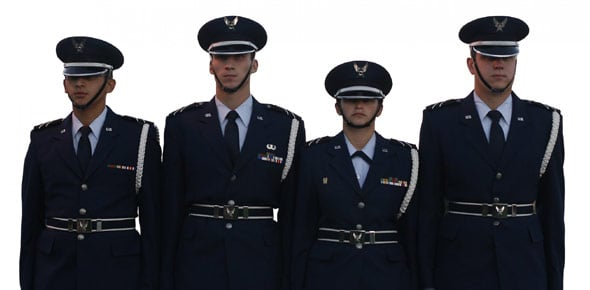What is the staff make-up for the S3?
What is a base already possessing resources and an established...
The tactic most commonly used by terrorist groups is
When should commanders and planners identify mission-critical...
Where is an excellent position to place a marksman in an urban area?
What provides key information to the defense force commander (DFC) and...
Observation post (OP)/listening post (LP) teams are not equipped to
When conducting ambushes, units refer to the engagement areas as
A typical organization of a terrorist group consists of
Our first line of defense against intelligence collection efforts is
Since unit type codes (UTC) are functionally grouped, what will all...
What is one of the fundamental purposes of the Law of Armed Conflict...
What should always be your first priority of work?
What would necessitate the need to dig hasty firing positions in the...
Where is the best position for you to locate an observation post...
A terrorist group that generally operates independently of, but...
To modify to prevent recognition of the true identity or character of...
Guidance on the application of force and exercising of the inherent...
What should the defense force commander (DFC) consider in the...
What does not need to be shown on a sketch?
At a minimum, which two S-functions must operate within the base...
When terrorists attack DOD affiliated personnel and facilities, what...
Compiling and examining all available information concerning potential...
Based on the integrated base defense (IBD) concept of operations...
A relatively secure area that allows for positive identification of...
Protective barriers consist of what two major categories?
Commanders do not use rules of engagement (ROE) to ensure operations
The USAF Antiterrorism Program is designed around what three...
Which threat level I activity is identified by random acts against...
In terms of engagement ranges, machine guns in the base-of-fire...
Against what threat levels can close precision engagement (CPE) add...
The primary responsibility of air base defense (ABD) forces is
What is the time limit for an air and space expeditionary force (AEF)...
When the machine gun is not assigned to the maneuver element, what is...
You should make restricted areas as small as possible to eliminate the
The tactical area of responsibility (TAOR) begins at the
The authority for establishing a national defense area (NDA) is shown...
The primary mission of a joint operation is
Generally, specially trained terrorists are of above average...
The political-military nature of military operations other than war...
Military operations other than war (MOOTW) missions do not include
Which essential element of the integrated base defense (IBD) concept...
Fixed bases having well-established perimeters usually have limited
What is an engagement priority for machine gun gunners to direct their...
The environment for security forces (SF) personnel working in the...
What factor is the stated desire or history of terrorist attacks...
How long are the majority of security forces (SF) unit type codes...
What two factors add depth to the battle outside the perimeter,...
Because the danger increases with the size of the weapons, how should...
What is the list of all unit type codes (UTC) approved for use in...
Directing your operation toward a defined and attainable objective...
Avoiding unnecessary complexity in organizing, preparing, planning,...
What is the main mission of the machine gun?
A "call for fire" is a message
When are terrorist team members brought together for final rehearsal?
The capability to reduce the capability of attacking forces and...
What group routinely manages the risk assessment process for...
When the need for a new unit type code (UTC) or a major change in an...
The immediate impression the entry control facility (ECF) must impart...
What assessment addresses the broad range of physical threats to the...
What does security forces (SF) provide for the Integrated Base Defense...
What does the Air Force maintain to support the on-call air and space...
When establishing base sectors, you must ensure critical resources and...
What pre-deployment factor is considered a constant?
What placement allows for redundancy in observation and better sector...
What does the risk management process allow the commander to...
What is not an example of a routine in defense measure?
Once fully implemented, what will the Integrated Base Defense Security...
What are the two types of obstacles you may encounter?
What operations are key to assembling an accurate picture of the...
Proper machine gun placement maximizes fire in
Which threat level uses doctrine that stresses the use of...
What unit type code (UTC) is essential to direct the fire of and...
What unit type code (UTC) is composed of one home station-validated...
What unit type code (UTC) consists of a 3-person team of specially...
The primary purpose of the operations security (OPSEC) program is to
The key to force protection (FP) countermeasure planning is
As a Total Force organization, a typical air and space expeditionary...
Which principle of indirect fire aims to destroy enemy soldiers and...
Missions that primarily target nuclear weapons-related facilities are...
An expeditionary military force is defined as a force that conducts...
What unit type code (UTC) is a 4-person team designed to provide...
In what way can subordinate joint force commands organize?
What is the key element in the design of forces that should be...
What unit type code (UTC), when deployed with UTCs QFEBB and QFEBS,...
What three subordinate areas are search areas divided into?
During peacetime operation, what unit type code (UTC) would provide...
Which threat spectrum level consists of small tactical units,...
The key to optimizing peacetime participation of the traditional...
Which military operations other than war (MOOTW) principle never...
















